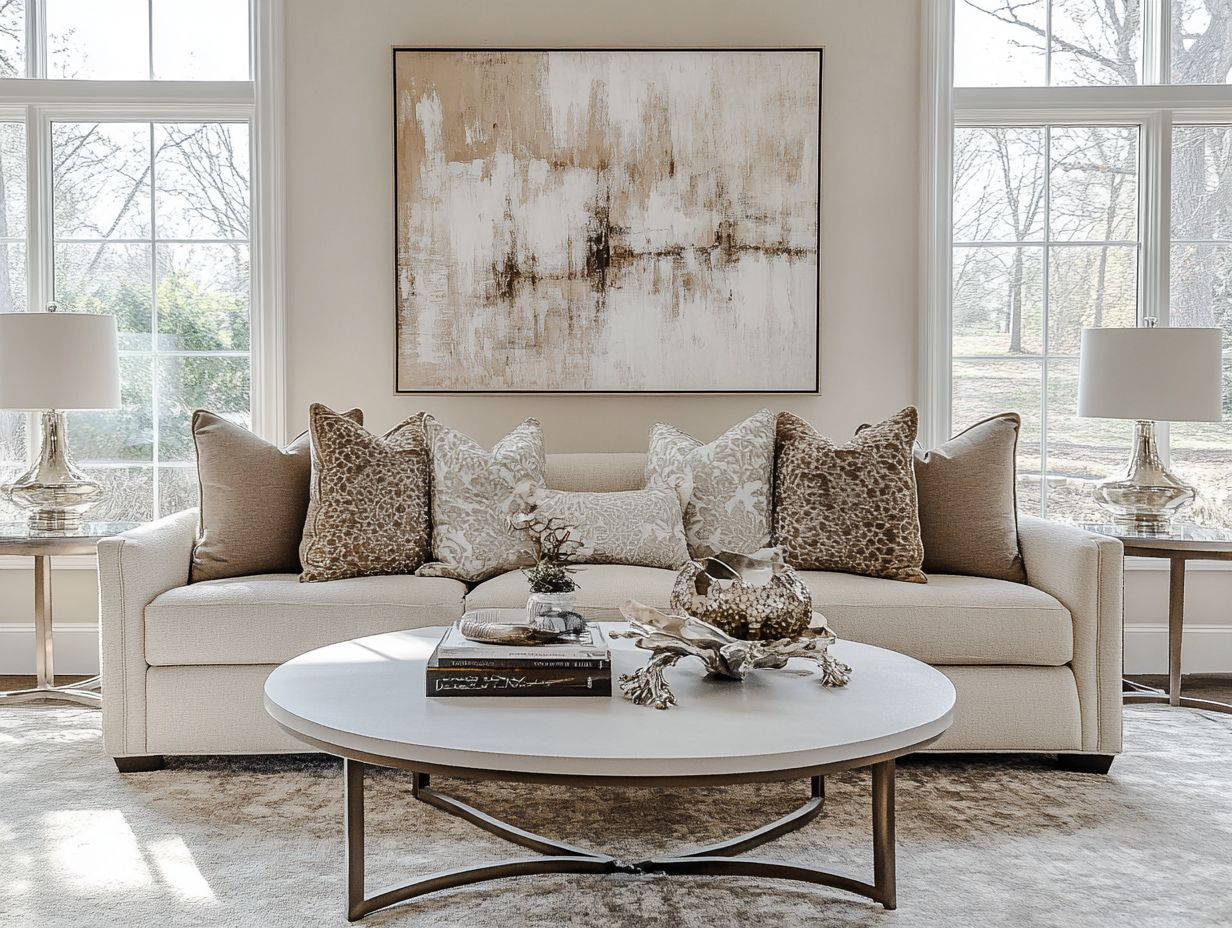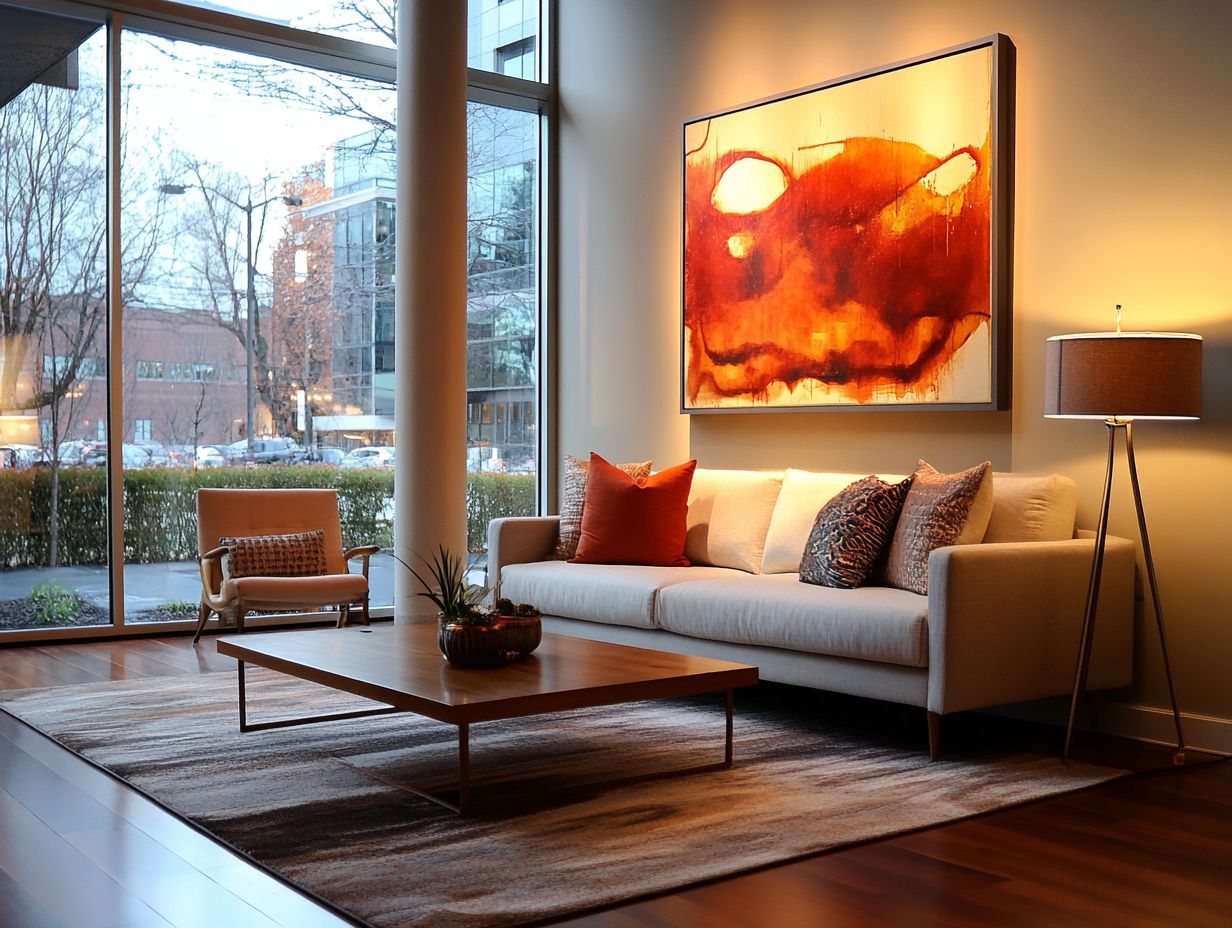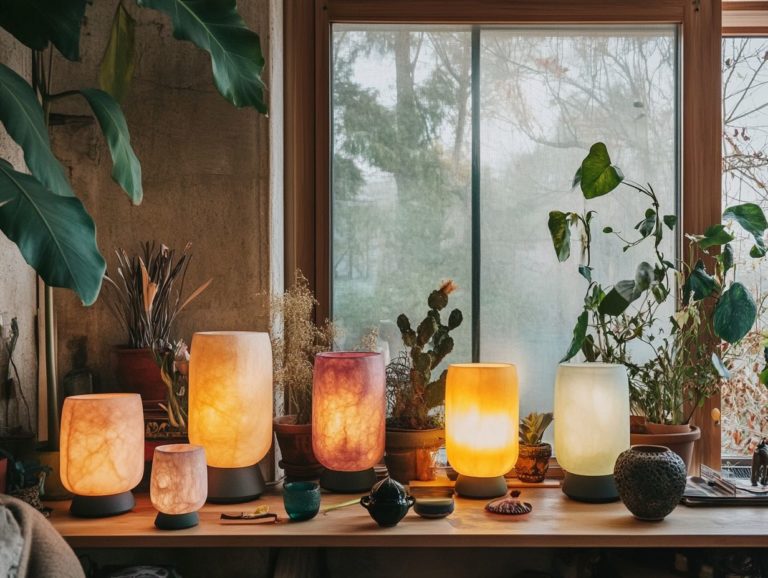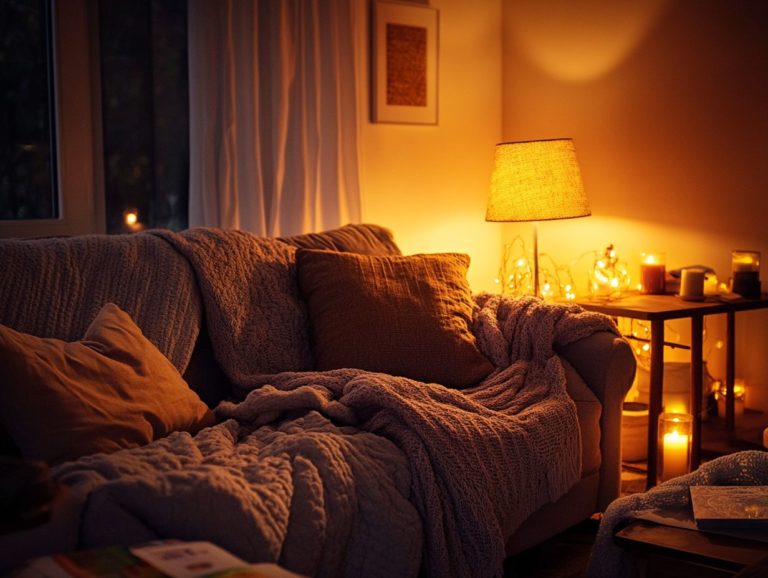“How to Use Lighting for Home Staging”
Home staging is an essential step in preparing a property for sale. One of the most powerful tools at your disposal is lighting.
Proper lighting enhances the aesthetics of a space and creates an inviting atmosphere. This allows potential buyers to envision themselves living there.
This article delves into the many benefits of lighting in home staging. You’ll discover different lighting types and strategic tips to make your home truly shine.
Whether you re a seller or a real estate professional, learn how the right lighting can elevate your staging.
Contents
- Key Takeaways:
- Benefits of Using Lighting in Home Staging
- Creating a Welcoming Atmosphere
- Types of Lighting for Home Staging
- Natural Lighting
- Artificial Lighting
- Strategies for Using Lighting in Home Staging
- Common Mistakes to Avoid
- Tips for Successfully Using Lighting in Home Staging
- Frequently Asked Questions
- 1. How can I use lighting to enhance the staging of my home?
- 2. What type of lighting should I use for home staging?
- 3. How can I use lighting to make small spaces appear larger?
- 4. What are some common mistakes to avoid when using lighting for home staging?
- 5. How can I use lighting to highlight specific areas of my home?
- 6. Can I use lighting to create a specific mood in my home?
Key Takeaways:

- Lighting plays a crucial role in home staging by enhancing the look and feel of a space.
- Natural lighting showcases a home’s beauty. Artificial lighting highlights key features and adds warmth.
- When using lighting for staging, consider each room’s function. Use a variety of light sources and maintain consistent styles.
What is Home Staging?
Home staging is about preparing your residential property for the competitive real estate market. It focuses on optimizing the space’s appearance to attract potential buyers.
By highlighting the property’s strengths and using thoughtful decor, you can create a warm environment that reinforces your home’s selling points. This helps buyers see your home’s true value.
To stage successfully, a staging expert selects a color palette that resonates with your target audience. Each room’s purpose should be clearly defined.
Using both natural and artificial lighting adds depth and warmth. This enhances the overall atmosphere, inviting buyers to imagine their lives in the space.
Creating a cozy ambiance involves details like decorative accents and furniture arrangements. These elements suggest the ideal lifestyle buyers might aspire to.
By considering these factors, home staging showcases your property’s full potential. It also allows buyers to form a personal connection with what could be their future home.
Benefits of Using Lighting in Home Staging
The benefits of incorporating lighting in home staging are numerous. It elevates a property’s overall appearance and creates an inviting atmosphere.
By using strategic lighting techniques, you can showcase architectural features and highlight each room’s unique selling points.
Enhancing the Look and Feel of a Space
Effective lighting choices can transform how potential buyers perceive a property. It makes a space feel more spacious and inviting.
When you place light fixtures properly and use balanced lighting, you create visual interest and emphasize the room’s purpose.
Incorporating a mix of soft white bulbs and various lamps crafts a warm ambiance that encourages relaxation. Reflective surfaces like mirrors amplify brightness, making a room feel larger.
In living areas, soft and layered lighting beautifully highlights architectural features. Bedrooms benefit from dimmable options to set the perfect mood.
In kitchens, task lighting above work areas ensures functionality without sacrificing aesthetics. Careful lighting choices achieve a harmonious balance, elevating the overall appeal of each space.
Creating a Welcoming Atmosphere
Creating a welcoming atmosphere in your home is crucial for leaving a lasting impression on potential buyers. It all starts with mastering lighting control. By opting for warm, inviting colors and thoughtful staging techniques, you can create a cozy environment that sparks an emotional connection.
To achieve this inviting vibe, think about using accent lighting. Strategically placed floor lamps or table lamps can cast a soft glow that highlights your home’s most appealing features. A color temperature around 2700K is ideal; it fosters an intimate feel both indoors and outdoors, making your spaces exceptionally inviting.
Add string lights or lanterns in outdoor areas to enhance the charm of your patio and create a relaxing vibe. Incorporating decorative accessories like candles or elegant light fixtures can further elevate the ambiance, transforming any space into a warm retreat that welcomes everyone with open arms.
Types of Lighting for Home Staging
Understanding the various types of lighting available for home staging is essential for maximizing your property’s appeal. By thoughtfully blending natural light with artificial lighting options, you can craft an inviting and well-illuminated atmosphere that elevates the home’s overall aesthetics.
Natural Lighting

Natural lighting is vital in home staging. It not only elevates the visual appeal of your spaces but also fosters an emotional connection with potential buyers. By maximizing natural light through the strategic placement of reflective surfaces and ensuring that windows remain unobstructed, your home can exude brightness and warmth.
Choosing the right window treatments like sheer curtains or easily adjustable blinds is just the beginning. Arrange your furniture thoughtfully so it doesn t block those important light sources. Open layouts enhance the flow of natural light between rooms, creating an airy ambiance that feels welcoming.
Don t overlook the impact of well-designed outdoor living areas either. With comfortable seating and lush greenery, these spaces can blur the lines between indoors and outdoors. This seamless transition cultivates a sense of tranquility, making your home feel inviting and significantly influencing how potential buyers perceive it.
Artificial Lighting
Artificial lighting plays a pivotal role in home staging. It enables you to craft the perfect atmosphere while showcasing the property’s standout features. The careful selection of lamps, light fixtures, and brightness levels can greatly elevate the appeal of every room.
It’s essential to grasp the different types of artificial lighting available. Task lighting, for instance, is designed to illuminate specific areas for activities like reading or cooking. Accent lighting effectively highlights artwork or architectural details. Understanding these nuances is key to achieving impactful home staging.
By incorporating these lighting styles, you can create a warm and inviting ambiance. Imagine pairing soft overhead lights with sleek task lamps; this combination not only enhances functionality but also elevates the overall aesthetic of your home.
Incorporating dimmers introduces versatility, allowing you to adjust the lighting to suit various times of day and moods. This ultimately enhances the cozy feel of each space.
Strategies for Using Lighting in Home Staging
When you implement effective lighting strategies in home staging, you can dramatically enhance your property’s appeal. By skillfully highlighting key features, creating depth and dimension, and ensuring balanced lighting throughout the space, you transform how potential buyers experience the home.
This thoughtful approach not only showcases the property s best attributes but also creates an inviting atmosphere that resonates with prospective buyers.
Start transforming your home today your potential buyers will thank you!
Highlighting Key Features
Highlighting the key features of a home through strategic lighting can profoundly enhance its overall appearance and forge a deeper emotional connection with potential buyers. By drawing attention to the property’s most attractive aspects, you can make them stand out, leaving a memorable impression.
Utilizing directional lighting is a powerful technique to achieve this, effectively showcasing artwork, architectural elements, or unique decor pieces. For example, positioning spotlights on a vibrant painting or an accent wall captures the eye and emphasizes these focal points. The choice of light fixtures whether chic pendant lights in a dining area or sophisticated sconces in a hallway can dramatically shape the atmosphere.
When paired with a carefully selected color palette that harmonizes with the lighting, these elements create layers of visual interest that enhance aesthetic appeal and evoke a sense of warmth and invitation. This smart strategy will captivate buyers and make them feel at home.
Creating Depth and Dimension
Creating depth and dimension in your home hinges on making thoughtful lighting choices that not only enhance the appearance of your spaces but also define different areas within a room. This approach cultivates a dynamic and inviting atmosphere that is bound to attract potential buyers.
By incorporating different types of lights, you can effectively layer illumination to showcase architectural features and artwork while fostering a cozy vibe. Don’t underestimate the power of shadows; when used wisely, they introduce visual interest and separate spaces without the need for physical barriers.
Paying attention to fixture placement can significantly enhance the perceived size of a room. Using wall sconces or pendant lights draws the eye upward, promoting an impression of spaciousness. Opt for soft, warm tones to elevate the mood, making your spaces feel more inviting and comfortable.
Adding Warmth and Ambiance
Adding warmth and ambiance to your home through effective lighting control can significantly influence buyer emotions and create a memorable experience. By utilizing warm light sources and refining your lighting placement, you can craft an inviting atmosphere that truly resonates with potential buyers.
Choosing the right color temperature for your light bulbs is crucial; soft white lighting provides a gentle glow that softens the sharp edges of furniture and architecture. Consider strategically positioning floor lamps and table lamps in key staging areas, such as living rooms and bedrooms, to draw attention to inviting seating arrangements or cozy nooks.
Dimmable lights are lights you can make brighter or dimmer, enhancing the ambiance depending on the time of day or the purpose of the space. By carefully orchestrating these elements, you can create an emotionally resonant experience that makes potential buyers feel right at home.
Common Mistakes to Avoid

Avoiding common pitfalls in home staging, especially when it comes to lighting, is crucial for grabbing the attention of potential buyers right away. Striking the right balance is key; over or under-lighting can undermine the property s appeal, while mismatched lighting styles can lead to confusion and weaken the emotional connection.
Prioritizing a harmonious lighting scheme will not only enhance the home’s aesthetics but also create an inviting atmosphere that resonates with visitors.
Over or Under Lighting
Too much light or too little light can drastically alter the appearance of a property, leading to negative perceptions from potential buyers. Striking the right balance is crucial for effectively showcasing the home’s unique features.
Poor lighting can warp room dimensions, making spaces feel either cramped or overwhelmingly open. This often induces a sense of disorientation. An excessively bright area might come off as sterile or harsh, while a lack of light can cast a gloomy, uninviting shadow over a room.
To achieve optimal lighting, consider the function of each area. For example, layering ambient, task, and accent lighting in living spaces can create a warm and inviting atmosphere. Bright, focused lighting in kitchens and workspaces enhances both functionality and safety.
With thoughtful lighting design, you can easily create a home that draws attention to its most appealing attributes and fosters a sense of comfort.
Mismatched Lighting Styles
Mismatched lighting styles can disrupt the overall decor and diminish the emotional connection potential buyers seek. Maintaining consistency in your lighting choices throughout the staging process is essential to creating a harmonious environment.
When selecting fixtures, consider how they coordinate with your furniture and the architectural elements of the space. For example, a modern pendant light can clash with a rustic farmhouse aesthetic, potentially alienating prospective homeowners.
For a cohesive look, opt for a variety of light sources like floor lamps, sconces, and chandeliers that align with your chosen theme. Neutral-toned fixtures are versatile choices, complementing different styles while enhancing your home s character and warmth.
Tips for Successfully Using Lighting in Home Staging
To effectively harness lighting in home staging, consider the function of each room and incorporate a diverse array of light sources. This strategy enhances the overall design and ensures a harmonious lighting style throughout.
By doing so, you create a cohesive and inviting atmosphere that captivates potential buyers. Don t miss out on the chance to impress buyers!
Maximize Each Room s Potential with Smart Lighting Choices
When selecting lighting options, it’s essential to consider the room’s function to truly optimize its use and create an emotional connection with potential buyers. Well-illuminated task areas foster a cozy atmosphere and highlight the room s purpose.
Take the kitchen, for example. Bright LED fixtures, which use energy-efficient light bulbs, can effectively light up work surfaces, making food preparation both safer and more enjoyable. Hanging pendant lights over the island not only infuse a touch of style but also direct illumination precisely where it s needed most.
In the living room, lean towards softer, warm-toned lighting. Think floor lamps with dimmers or recessed ceiling lights that cultivate a relaxing ambiance perfect for social gatherings or unwinding after a long day.
By strategically placing wall sconces for added warmth or incorporating table lamps with shaded designs, you enhance the room’s inviting nature while supporting its primary function.
Use a Variety of Light Sources
Utilizing a variety of light sources in home staging is essential for achieving that perfect balance of lighting. This elevates the space s appearance and injects visual interest. This strategy offers greater control over the lighting and enhances flexibility in crafting the desired atmosphere.
By effectively incorporating ambient, task, and accent lighting, you create a harmonious blend of functionality and aesthetics. Ambient lighting lays the groundwork, providing overall illumination, while task lighting focuses on specific activities, ensuring spaces like work areas or reading nooks are perfectly lit. Accent lighting highlights architectural features or decorative elements, guiding the eye and establishing focal points.
When staging a home, create an inviting ambiance by thoughtfully layering these light sources. Pair warm-toned ambient lights with adjustable desk lamps and strategically placed sconces to add depth and character, allowing potential buyers to easily envision themselves in the space.
Stay Consistent with Lighting Styles

Staying consistent with lighting styles throughout your home is crucial for crafting a cohesive environment that resonates with potential buyers. Inconsistent lighting choices can confuse or detract from your home’s overall appeal.
Achieving harmony in lighting highlights the design elements of your space and elevates the overall aesthetic. This makes each room feel inviting and thoughtfully designed.
When you select lighting fixtures, consider how they align with your existing decor and the desired ambiance. For instance, pendant lights with warm tones can create a cozy atmosphere in the kitchen. In contrast, sleek, modern fixtures may suit a minimalist living room perfectly.
Integrating different layers of lighting such as overall light, specific task light, and focused accent light ensures functionality while enriching the atmosphere. This approach allows each area of your home to shine in its own unique way.
Frequently Asked Questions
1. How can I use lighting to enhance the staging of my home?
Transform your home with different types of lighting! Lighting plays a crucial role in home staging by creating an inviting and welcoming atmosphere. Highlight the best features of your space and captivate potential buyers.
2. What type of lighting should I use for home staging?
When it comes to home staging, natural light is always the best option. However, if natural light is limited, use a combination of overall and task lighting to create a warm and inviting atmosphere.
Avoid harsh or bright lights, as they can make your home appear uninviting and unappealing.
3. How can I use lighting to make small spaces appear larger?
In small spaces, use lighting strategically to create the illusion of more space. Recessed lighting or wall sconces can direct light upwards, creating a sense of height in the room.
Mirrors can also reflect natural light to make the room appear larger.
4. What are some common mistakes to avoid when using lighting for home staging?
One common mistake is using mismatched light fixtures throughout the home. Stick to a cohesive design and choose fixtures that complement each other.
Another mistake is relying on only one source of light, which can create harsh shadows. Instead, use a combination of lighting to create a balanced and inviting atmosphere.
5. How can I use lighting to highlight specific areas of my home?
If you want to draw attention to certain areas of your home, like artwork or unique features, use accent lighting. This type focuses on specific spots and can highlight your home’s best features.
6. Can I use lighting to create a specific mood in my home?
Absolutely! Lighting can greatly impact the mood and atmosphere of a room. For a cozy feel, use warm and dim lighting.
If you want to create a bright and energetic space, opt for cool and bright lighting. Experiment with different types of lighting to find the perfect mood for your home staging.






